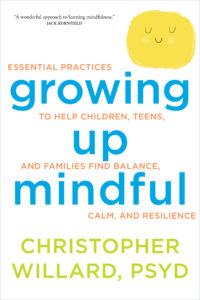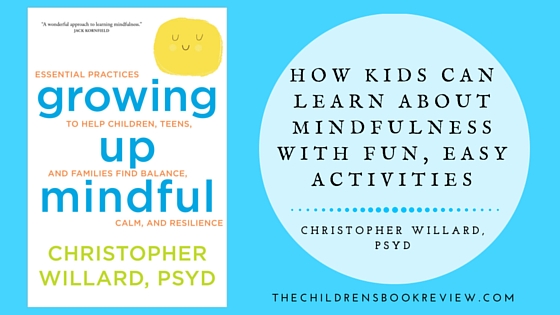Christopher Willard, PsyD | The Children’s Book Review | June 6, 2016
When we think about the crazy idea of teaching kids mindfulness, it can help to think about how do we teach kids anything? And the answer is simple—make it easy, make it short, and most of all, make it fun. But getting kids to sit or stand still? How is that fun?
Lev Vygotsky, noted child development researcher, once did a little experiment trying to see how long he could get a group of eight-year-olds to stand still. The result was about as effective as anyone else trying such a feat. But then he decided to suggest they stand still imagining that they were guards at a factory, with the result that the kids were standing still almost four times as long as the simple instructions he’d given them earlier. What can we learn about teaching, and about teaching stillness?
When we make something fun, and engage the imagination, children especially are apt to learn. Inspired in this way, we can use guided imagery, games, and playacting when we teach mindfulness. One form of mindful walking for example, is taught to us adults when we try to bring our awareness to the physical sensations of walking. It’s quite wonderful practice, and often a favorite way to practice mindfulness among adults, but it sure might sound boring to a child. But if we ask them to walk as quietly as possibly like a spy, or imagine they are walking carefully over an icy pond, they can focus more readily on the task, and really bring a new awareness to walking that also becomes fun.
Likewise for breathing, a child I worked with years back once informed me with an eye roll that “deep breathing is played out.” For that matter, it can be hard to just focus on the breath for very long. But what if we imagine we are holding a steaming bowl of our favorite soup or oatmeal, and gently inhale through our nose as if we are smelling it, and exhale through our mouth as if we are blowing on it to cool it off before we enjoy it. “The Soup Breath” is a relaxing and familiar way to slow down the breath and rest our attention on something, and so learn the basics of mindful awareness. And if your kids don’t like soup, there’s always hot chocolate, pizza, or plenty of other kid-friendly foods from which to choose.
And we can find a few minutes in our busy days to do a soup breath here, or some mindful walking there, which over time kids can use to help themselves when they are stressed, emotional, or maybe just bored and looking for something to do. A moment or two before dinner is ready, a few minutes of boredom while waiting for the school bus, these are great opportunities to teach some patience and mindfulness to our kids and ourselves.
###
About Christopher Willard, PsyD

Christopher Willard, PsyD, is a clinical psychologist and consultant specializing in bringing mindfulness into education and psychotherapy. He teaches at Harvard Medical School and Lesley University, and is the author of Growing Up Mindful: Essential Practices to Help Children, Teens, and Families Find Balance, Calm, and Resilience (Sounds True, June 2016). You can find him at http://drchristopherwillard.com and on Twitter at @drchriswillard.
 Growing Up Mindful: Essential Practices to Help Children, Teens, and Families Find Balance, Calm, and Resilience
Growing Up Mindful: Essential Practices to Help Children, Teens, and Families Find Balance, Calm, and Resilience
Written by Christopher Willard, PsyD
Publisher’s Synopsis: Introducing mindfulness into the lives of our children and teenagers is perhaps the greatest gift we can offer. Mindfulness builds emotional intelligence, boosts happiness, increases curiosity and engagement, reduces anxiety and depression, soothes the pain of trauma, and helps kids (and adults) focus, learn, and make better choices. If that weren’t enough, research now shows that mindfulness significantly enhances what psychologists call “flourishing”—the opposite of depression and avoidance.
Growing Up Mindful helps parents, educators, and counselors learn how to embody and share the skills of mindfulness that will empower our children with resilience throughout their lives. With more than 75 accessible exercises and practices, along with adaptations for the individual needs of a wide range of children and teens, this inspiring guidebook brings you road-tested insights and tools for:
• Tapping the power of the imagination, play, and creativity
• Body-based mindfulness and movement practices
• Creatively overcoming resistance and gaining kids’ buy-in
• The mindful use of technology and social media
• Building the foundation through your own personal practice
• “Attending” and “Befriending”—two positive responses to stress
• Setting intentions and managing expectations of new practitioners
• Sharing mindfulness in a formal setting including schools and workplaces
• Extending our practice into the larger communities we share
“Seeds of mindfulness can be planted in anyone at any time—seeds that under the right conditions can burst and bloom into a life of compassion and connection,” writes Dr. Willard. Growing Up Mindful invites you to “embark on something incredible and world-changing” as you join the growing community of adults bringing wonder, curiosity, and reflection back into childhood and adolescence.
Adults | Publisher: Sounds True | 2016 | ISBN-13: 978-1622035908
Available Here:
Discover more articles and books like Growing Up Mindful, by Christopher Willard, PsyD, by checking out our reviews and articles tagged with Emotional Intelligence, Mindfulness, Sounds True Books, Health, and Parenting Books.


3 Comments
You’ve got the most impressive internet sites
I love the information on your site. Many thanks!.
That is a great tip particularly to those fresh to the blogosphere.
Simple but very accurate info… Thank you for sharing this one.
A must read post!